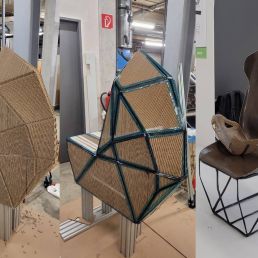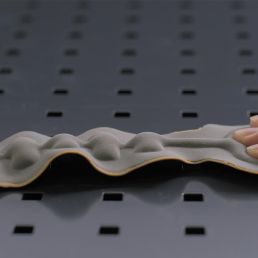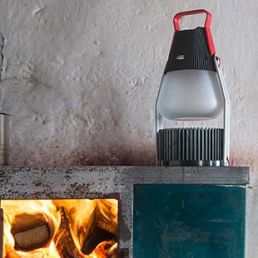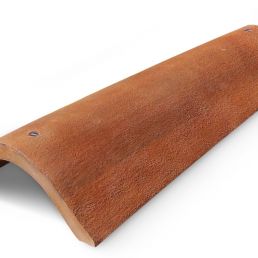
3D printed wooden windows
NorDan group was the first window manufacturer in the world to launch 3D printed windows for commercial sales.
5 Januar 2020
In October 2019, NorDan was the first window manufacturer in the world to launch 3D printed windows for commercial sales. The first 3D printed windows series are circular windows. The products are sold in sizes from 40 cm to 120 cm in diameter. The unique large-scale 3D printer of NorDan was designed and manufactured by BLB Industries in Sweden and can print windows and doors up to 1.5 m wide and 2.5 m height.
Gantry based 3D printer with two extruders, and control systems from Bosch
NorDan`s 3D printer has been designed to use granulates, which is much more affordable and industrial viable than the expensive filament material which is commonly used for 3D plastics printers. NorDan’s big 3D printer has outside dimensions width 2.4 m, height 2.7 m and length 4.0 m. It is a gantry based 3D printer with two extruders, and control systems from Bosch. As for printing raw material, NorDan has decided to use biocomposite granulates from Stora Enso, a leading biomaterial company. The DuraSense biocomposite material has a high content of wood fibre, FSC-certified, in combination with polypropylene to make 3D printing possible. From a cost perspective, the granulate material for 3D printing is much more affordable than filament material. Printed products in the DuraSense biomaterial can be recycled with a high recycling rate.
The 3D printed windows sold by NorDan in the Scandinavian market has undergone extensive product testing at the Research Institutes of Sweden (RISE) in Borås, and successfully passed all relevant test for commercial windows including wind load, water resistance, temperature cycles and mechanical strength (Wind load Class 3 (EN 12210:1999), water resistance Class 9A (EN 12208:1999), U-value 0,87 W/m2K and CE marked). Also, the 3D printed circular windows are available as BIM models on www.bimobject.com and the product is listed in various environmental declaration databases.

image: Nordan BIG Granular Printing
NorDan has found that at the current level of technology development in large-scale 3D printing there are many advantages but also some challenges in producing windows and doors using 3D printers. The biggest advantages are found in the printing of shaped windows, i.e. circular, half circular, angled windows:
- Total lead time from customer order to delivery can be reduced by more than 50%
- Cycle time of producing the window can be reduced by more than 70%
- Direct hours can be reduced by more than 60%
- Improved quality and HSE
Some of the challenges are to establish a repeatable printing process and that it is required to control a lot of process parameters. It is not yet a “plug and play” solution. However, once the program and process are set, series production can commence, just like NorDan so successfully has demonstrated. The 3D printed windows in biocomposite by NorDan has already been awarded Quality Innovation Award 2019 in Sweden and received much attention in the media covering the Scandinavian construction industry.
NorDan has invested in additive manufacturing technology as part of its “ecoDigital ready” strategy and to explore the possibilities that reside in additive manufacturing. “ecoDigital ready” is a trademark of NorDan and is the name of the company’s strategy for digitalization and sustainability. The big 3D printer that NorDan has invested in, is continuously in use also for new processes and product developments. After the launch of 3D printed circular windows, the focus is now on producing 3D printed doors, 3D printed square windows as well as looking at flexible solutions for installation of windows and doors in concrete panels for buildings. Also, different types of biomaterial granulate are being tested, including different types of woods and plant fibres.
The text was written by Dr. Dag Kroslid (COO of NorDan Group and CEO of NorDan Sweden).
image: NorDan
Ecoblaq molecular wood colours
23 March 2024
Ecoblaq is a molecule manipulation method, a natural chemical reaction, making…
Natural fiber reinforced car seat
22 October 2023
The focus of the project "Design for Recycling" is a seat shell that is made…
MotorSkins morphing textiles
19 April 2022
Berlin based start-up MotorSkins designs and produces textiles with embedded…
3D Pioneers Challenge 2022
15 December 2021
The 3D Pioneers Challenge 2022 adresses tech pioneers who pave the way for…
IGNIS – Light from waste heat energy
12 August 2020
The availability of affordable, independent and, above all, clean electrical…
Brake disc with reduced fine dust
21 April 2021
Fine dust endangers our health. One of the main sources is traffic, especially…
Texoversum
15 July 2023
With the "Texoversum", Reutlingen University has put into operation a training…
Invisible Terracotta Solar Rooftile
10 May 2023
The family-run business Dyaqua has developed a technology to integrate a…
Xarvio – Digital Farming
8 January 2021
BASF Digital Farming GmbH has received the renowned Crop Science Award for the…








